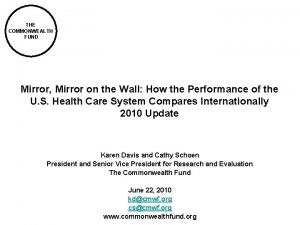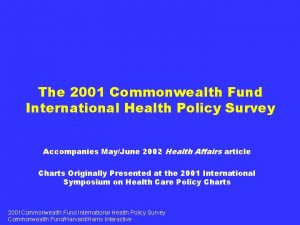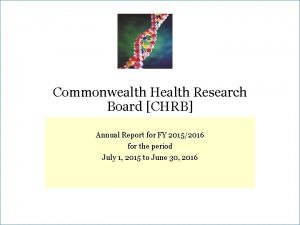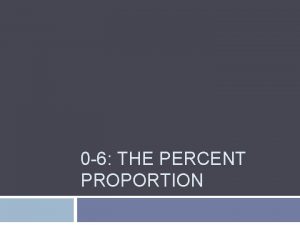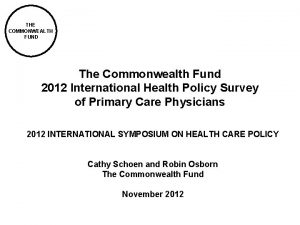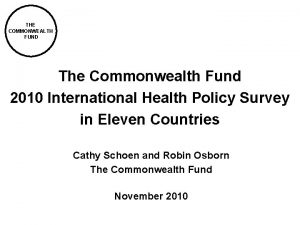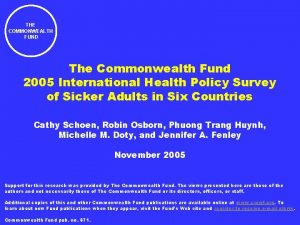How Canada Compares Results From The Commonwealth Fund

































































- Slides: 65

How Canada Compares: Results From The Commonwealth Fund 2015 International Health Policy Survey of Primary Care Physicians Report January 2016

Production of this document is made possible by financial contributions from Health Canada and provincial and territorial governments. The views expressed herein do not necessarily represent the views of Health Canada or any provincial or territorial government. All rights reserved. The contents of this publication may be reproduced unaltered, in whole or in part and by any means, solely for non-commercial purposes, provided that the Canadian Institute for Health Information is properly and fully acknowledged as the copyright owner. Any reproduction or use of this publication or its contents for any commercial purpose requires the prior written authorization of the Canadian Institute for Health Information. Reproduction or use that suggests endorsement by, or affiliation with, the Canadian Institute for Health Information is prohibited. For permission or information, please contact CIHI: Canadian Institute for Health Information 495 Richmond Road, Suite 600 Ottawa, Ontario K 2 A 4 H 6 Phone: 613 -241 -7860 Fax: 613 -241 -8120 www. cihi. ca copyright@cihi. ca ISBN 978 -1 -77109 -424 -5 © 2016 Canadian Institute for Health Information How to cite this document: Canadian Institute for Health Information. How Canada Compares: Results From The Commonwealth Fund 2015 International Health Policy Survey of Primary Care Physicians. Ottawa, ON: CIHI; 2016. Cette publication est aussi disponible en français sous le titre Résultats du Canada : Enquête internationale 2015 du Fonds du Commonwealth sur les politiques de santé auprès des médecins de soins primaires. ISBN 978 -1 -77109 -425 -2

Table of contents Executive summary 5 About this report 10 Access to care 12 Timely access to care 13 Cost as a barrier to health care 17 Coordination of care 23 With specialists 24 With hospitals 26 Between patient visits 29 With home care and social services 30 Inefficiencies resulting from poor coordination 35 How organization of practice influences care 37 How Canadian doctors are practising 38 Primary care models and coordination of care 40 Primary care models and electronic medical records 41 Primary care models and access to care 42 3

Table of contents (cont’d) IT adoption 43 Use of electronic medical records (EMRs) 44 Computerized care decision support 47 Electronic communication for patients 49 Performance measurement 50 Measuring patient outcomes and experience 51 Monitoring preventive care 52 Performance measurement against benchmarks and peers 54 Acknowledgements and methodology notes 56 Appendix 61 Demographics 62 Practice type and organization 64 Bibliography 65 4

Executive summary For most people, primary care clinicians such as family doctors and nurses are the first point of contact with the health care system. They provide and coordinate the care that people need to manage their health problems in the community, and help to prevent people from getting sick in the first place. Research shows that good primary care provides better care for patients at a lower cost to the health system. Across Canada, there have been many efforts to improve the delivery of primary care. By providing comparable information on the experiences of primary care doctors in 10 countries, The Commonwealth Fund 2015 International Health Policy Survey provides an important perspective on how well primary care works in Canada and where improvements still need to be made. From the point of view of primary care doctors, access to care continues to pose significant challenges for Canadian patients. When doctors are asked how well care for their patients is coordinated with other health or social services providers, results are mixed in this country and show room for improvement overall. And Canadian primary care doctors are less likely than their peers in other countries to use information technology to manage patient care, and to measure and monitor the performance of their clinics. On a more positive note, Canadian results that can be compared over time seem to be improving. Further analysis shows that new models of primary care delivery appear to be making a difference for patients in Canada; doctors working in family health teams (or other funded models of primary care) outperform their peers in most measures of access, continuity and quality of care. 5

Executive summary (cont’d) Finally, results show significant provincial variation across the country. This suggests we can collectively reflect on and learn from the policies and programs that have proven to be most effective elsewhere in Canada or in other comparator countries. The matrix below provides a summary of Canadian results by theme compared with the international average of countries. The number in each cell represents the number of indicators in each theme that are below, the same as or above The Commonwealth Fund (CMWF) average of 10 countries. Below average Same as average Above average Access to care 5 1 0 Coordination of care 6 1 6 Information technology adoption 4 0 0 Performance measurement 4 1 0 6

Executive summary (cont’d) Access to care Primary care doctors report that timely access to primary and specialist care remains a challenge in Canada. • Only 53% of doctors report that most of their patients who request a same- or next-day appointment can get one. Less than half (48%) of doctors have arrangements for their patients to see a doctor or nurse when the practice is closed (after hours) without going to the hospital emergency department. These results are among the lowest in comparison with other countries in the survey. • However, timely access to primary care has improved over time; one-third more doctors in Canada are able to provide same- or next-day access in 2015 than in 2009. • 7 in 10 primary care doctors in Canada say their patients often experience long wait times to see a specialist, the highest proportion of all 10 countries. Canadian doctors report more difficulties in getting diagnostic tests for their patients, though time to treatment after diagnosis is similar to the international average and improving in Canada. • Canadian doctors are more likely to report that their patients often have difficulty paying for medications or other out-of-pocket costs (30%). Reported cost barriers to care vary significantly across the country. 7

Executive summary (cont’d) Coordination of care between primary care doctors and other health providers and services varies by sector, and shows room for improvement across the board. • Canadian primary care doctors are more likely (29%) to say that they always receive relevant health information from specialists than doctors in other countries (23%). • Canadian primary care doctors wait the longest on average to receive discharge information from hospitals. 22% waited more than 15 days for reports on their patients who were recently hospitalized in order to continue managing their care. • Coordination of care with home care services and other social services is lower in Canada than in most other countries. • 50% of Canadian primary care doctors report that at least 1 patient experienced problems in the past month because care was poorly coordinated across health care sectors. This is slightly lower than the international average but still high. • Coordination of care for patients varies widely by province, with some provinces reporting results on par with or better than the international average. 8

Executive summary (cont’d) Organization of practice The way primary care is organized influences how care is delivered. In general, Canadian physicians working in models supported by public funds had better overall results than their Canadian peers in other models. • 51% of Canadian doctors say that they work in a primary care model that is supported by public funds. * • These doctors reported that their practices were more likely to coordinate care with other health care providers, monitor patients between visits and provide after-hours arrangements for their patients than doctors who were not a part of these models. Information technology and performance measurement Use of electronic medical records (EMRs) to manage patient care is lower in Canada than the international average, but uptake is increasing. However, measuring the performance of primary care is still not standard practice in this country. • Fewer Canadian primary care doctors (73%) use EMRs compared with the international average (88%). However, uptake has doubled in Canada since 2009 (37%). • Of those who have EMRs, Canadian doctors are less likely to use them to understand the health of their patients or to help make decisions to care for them. • Canadian primary care doctors are considerably less likely than doctors in other countries to routinely review surveys on patient satisfaction and patient experiences (17% versus 47%) or to compare their performance with that of other primary care practices (17% versus 37%). * Examples include groupes de médecine de famille (GMFs) or cliniques-réseau in Quebec, family health teams in Ontario, and primary care networks or family care clinics in Alberta. 9

About this report The 2015 edition of The Commonwealth Fund International Health Policy Survey focused on the views and experiences of primary care doctors. This report highlights the Canadian story and examines how these experiences vary across Canada and relative to other developed countries. Questions that were asked of only Canadian respondents are indicated throughout this report using a maple leaf. To provide additional context, this report references information from the Canadian Institute for Health Information (CIHI) and other sources. References can be found in the notes section of applicable slides. All other data is from The Commonwealth Fund 2015 International Health Policy Survey of Primary Care Physicians. Supplementary data tables are available online. These cover additional topics such as chronic disease management and physician satisfaction. Full data sets of the survey results are available to researchers upon request at cmwf@cihi. ca. 10

About this report (cont’d) Interpreting results CIHI applied statistical methods to determine whether Canadian and provincial results were significantly different from the international average of 10 countries. Results are displayed throughout the report using the following colour codes: Above average Same as average Below average Above average results are more desirable relative to the international average, while below average results often indicate areas in need of improvement. This method measures only what is statistically different and not necessarily what is a large variation in results. In addition, sample sizes in some provinces are much smaller than in others and have wider margins of error. For this reason, 2 provinces may have the same numeric results in different colours (e. g. , 1 result might be green, or same as average, while the other is orange, or below average). The wider the margin of error, the more difficult it is for a result to show up as significantly different from the average. The most robust samples are in Quebec and Ontario because of the additional funding from those provinces. 11

Access to care Timely access to care Barriers to health care 12

Timely access to primary care a challenge in Canada but improving 53% of Canadian primary care doctors reported that almost all or most of their patients who request a same- or next-day appointment can get one. How does Canada compare (2015)? 85% Switzerland Germany Comparison by year 100% 80% 76% 75% New Zealand 72% Netherlands 60% United States 40% Australia CMWF average 72% Norway United Kingdom CANADA Sweden 39% 53% 45% 20% 0% 53% 42% 2009 Canada 2012 2015 CMWF 13

Access to after-hours care significantly below average in Canada 48% of Canadian doctors have an arrangement in their practice where patients can see a doctor or nurse if needed when the practice is closed (after hours) without going to the hospital emergency department. How does Canada compare (2015)? Netherlands 94% Comparison by year 80% 75% 63% 75% New Zealand 60% United Kingdom Germany 40% Norway 43% 48% 45% Australia 20% Sweden CMWF average 75% 0% Switzerland CANADA United States 48% 39% 2009 Canada 2012 2015 CMWF 14

Canadian doctors report timelier access to primary care than patients Same or next-day appointments Patients who said they could get a same- or next-day appointment Primary care physicians who said most (at least 60%) of their patients can get a same- or next-day appointment 2013 38% 2012 45% 2015 53% After-hours care Patients who said it was easy or somewhat easy to access medical care after hours without going to the emergency department Primary care physicians who reported having after-hours care arrangements 2013 2012 2015 32% 45% 48% 15

How do the provinces compare? Despite some variation among provinces, access to timely primary care in Canada is significantly lower than the international average in all reporting provinces. Proportion of primary care doctors who B. C. Alta. Sask. Man. Ont. Que. N. B. N. S. N. L. Can. CMWF avg. Were able to provide a same- or next-day appointment to almost all or most of their patients 56% 53% 54% 52% 66% 34% 45% 56% 51% 53% 72% Have an arrangement where patients can see a doctor or nurse if needed when the practice is closed (after hours) without going to the hospital emergency department 31% 52% 43% 26% 67% 39% 41% 33% 48% 75% Compared with the CMWF average results Above average Same as average Below average 16

Barriers to care: Access to diagnostic imaging often more difficult in Canada 40% of Canadian primary care doctors thought their patients often experienced difficulty getting specialized diagnostic tests (e. g. , CT imaging, mammogram, MRI). How does Canada compare (2015)? New Zealand Comparison by year 54% CANADA 40% United States Germany CMWF average 21% United Kingdom Sweden Australia Norway Netherlands Switzerland 50% 45% 40% 35% 30% 25% 20% 15% 10% 5% 0% 47% 38% 31% 23% 2009 1% Canada Compared with the CMWF average results Above average Same as average Below average 40% 2012 2015 CMWF Interpretation note: Above-average results are more desirable relative to the international average, while below-average results often indicate areas in need of improvement. 17

Wait times for specialists are longest in Canada 70% of Canadian primary care doctors thought their patients often experienced long wait times to see a specialist. Comparison by year How does Canada compare (2015)? 70% CANADA 80% New Zealand 70% Germany 60% Australia 50% Sweden 40% Norway CMWF average 70% 50% 45% 48% 20% 10% United States 0% Netherlands 2009 9% Canada Compared with the CMWF average results Above average 73% 30% 45% United Kingdom Switzerland 75% Same as average Below average 2012 2015 CMWF Interpretation note: Above-average results are more desirable relative to the international average, while below-average results often indicate areas in need of improvement. 18

Wait times for treatment after diagnosis are improving in Canada 21% of Canadian primary care doctors thought their patients often experienced long wait times to receive treatment after diagnosis. How does Canada compare (2015)? New Zealand Comparison by year 33% United Kingdom 35% 30% Sweden CANADA 20% 21% CMWF average 25% 21% 23% 19% 15% 19% Norway 10% Germany 5% Netherlands 0% United States 2009 1% Canada Compared with the CMWF average results Above average 24% 25% Australia Switzerland 29% Same as average Below average 2012 2015 CMWF Interpretation note: Above-average results are more desirable relative to the international average, while below-average results often indicate areas in need of improvement. 19

Canadians wait longer to see specialists but less time for priority surgeries Proportion of patients who waited 2 months or more to see a specialist Median wait times for diagnostic tests in 2014 (days) 28% Pan-Canadian population-weighted average based on Alberta, Manitoba, Nova Scotia, Ontario and Prince Edward Island. Source: Wait Times Database, CIHI. 13% Canada CMWF Median wait times for priority procedures in 2014 (days) 48 Canada 73 CMWF Cataract surgery 87 Canada 126 100 98 CMWF Canada Hip replacement CMWF average based on Australia, Canada, New Zealand, Norway and the United Kingdom. CMWF Knee replacement 20

Medication cost barriers for patients are higher in Canada than in most other countries 30% of Canadian primary care doctors thought their patients often experienced difficulty paying for medications or other out-of-pocket costs. How does Canada compare (2015)? United States 60% Netherlands Canada 30% New Zealand Australia CMWF average 24% In 2013, 1 in 12 Canadians reported that they did not fill a prescription for medicine or skipped doses of their medicine because of the cost. Germany United Kingdom Switzerland Sweden Norway 3% Compared with the CMWF average results Above average Same as average Below average Interpretation note: Above-average results are more desirable relative to the international average, while below-average results often indicate areas in need of improvement. 21

How do the provinces compare? Canadian primary care doctors report that their patients often experience more access barriers than the international average. Proportion of primary care doctors who thought their patients often B. C. Alta. Sask. Man. Ont. Que. N. B. N. S. N. L. Can. CMWF avg. Have difficulty getting specialized diagnostic tests (e. g. , CT imaging, mammogram, MRI) 58% 37% 25% 20% 64% 27% 30% 40% 21% Experience long wait times to see a specialist 75% 72% 57% 68% 60% 81% 70% 75% 64% 70% 45% Experience long wait times to receive treatment after diagnosis 32% 19% 17% 14% 20% 14% 25% 15% 21% 19% Have difficulty paying for medications or other out-of-pocket costs 43% 27% 27% 31% 22% 51% 36% 30% 24% Compared with the CMWF average results Above average Same as average Below average Interpretation note: Above-average results are more desirable relative to the international average, while below-average results often indicate areas in need of improvement. 22

Coordination of care With specialists With hospitals Between patient visits With home care and social services Inefficiencies resulting from poor coordination 23

Coordination with specialists better than average in Canada, but all countries have low results When their patient has been seen by a specialist, Canadian primary care doctors always received Canada CMWF average A report back from the specialist with all relevant health information 29% 23% Information about changes the specialist made to the patient’s medication or care plan 27% 23% Information that is timely and available when needed 13% 9% Compared with the CMWF average results Above average Same as average Below average 24

How do the provinces compare? Coordination of care between primary doctors and specialists is above the international average in most Canadian provinces, but there is still room to improve overall. When their patient has been seen by a specialist, Canadian primary care doctors always received B. C. Alta. Sask. Man. Ont. Que. N. B. N. S. N. L. Can. CMWF avg. A report back from the specialist with all relevant health information 33% 25% 42% 38% 31% 17% 42% 43% 38% 29% 23% Information about changes the specialist made to the patient’s medication or care plan 33% 21% 39% 34% 31% 12% 37% 43% 36% 27% 23% Information that is timely and available when needed 18% 14% 18% 20% 14% 4% 10% 17% 13% 9% Compared with the CMWF average results Above average Same as average Below average 25

Coordination with hospitals similar to average in Canada 47% of Canadian primary care doctors or other personnel in their practice frequently coordinate follow-up care with hospitals for patients being discharged. How does Canada compare (2015)? Germany 66% United Kingdom United States Netherlands CANADA 47% CMWF average 46% Switzerland Australia New Zealand Sweden Norway 25% In 2013, 74% of Canadians reported that when they were discharged, the hospital made arrangements for or made sure they had follow-up care with a doctor or other health care professional. 26

Coordination of discharge information from hospitals less timely in Canada 22% of Canadian primary care doctors said it takes more than 15 days on average to get the information they need after a patient is discharged from hospital to continue managing the patient’s care. More than 15 days or never Less than 2 days Germany 68% CANADA New Zealand Sweden United States Australia Netherlands Switzerland CMWF. . . CMWF average 39% United States Australia Germany 22% Netherlands Norway Sweden Norway 19% New Zealand Compared with the CMWF average results Above average 9% United. . . United Kingdom CANADA 22% Same as average Below average 2% Interpretation note: Above-average results are more desirable relative to the international average, while below-average results often indicate areas in need of improvement. 27

How do the provinces compare? Primary care doctors in most provinces wait longer than the international average before they receive management plans for their patient after discharge from the hospital. Proportion of primary care doctors who reported that they or other personnel in their practice frequently Coordinate follow-up care with hospitals for patients being discharged B. C. Alta. Sask. Man. Ont. Que. N. B. N. S. N. L. Can. CMWF avg. 50% 38% 50% 37% 65% 56% 47% 46% 64% 57% Length of time, on average, for primary care doctors to receive the management plan after a patient has been discharged from the hospital B. C. Alta. Sask. Man. Ont. Que. N. B. N. S. N. L. Can. CMWF avg. Less than 2 days 30% 23% 26% 20% 28% 9% 18% 23% 16% 22% 39% More than 15 days or never 8% 24% 18% 21% 11% 44% 28% 9% 31% 22% 9% Compared with the CMWF average results Above average Same as average Below average Interpretation note: Above-average results are more desirable relative to the international average, while below-average results often indicate areas in need of improvement. 28

Home contact with patients is less frequent in Canada Proportion of primary care doctors who reported that they or other personnel in their practice frequently provide care in the following ways: Contact patients between visits to monitor their condition Make home visits Netherlands 88% United Kingdom New Zealand Germany Netherlands Switzerland United States CMWF average 39% Germany Australia Sweden CMWF average New Zealand CANADA Norway Australia CANADA United States 19% 6% 54% United Kingdom 34% 28% Switzerland Norway 16% 29

Primary care and home care services not as integrated in Canada Practice routinely communicates with a case manager or home care provider about a patient’s needs when a patient is receiving home care services Norway 63% Primary care doctors are routinely advised of a relevant change in the condition or health status of their patients who are receiving home care services Switzerland Netherlands Germany Switzerland Netherlands Sweden United States Germany Norway United States CMWF average 43% 29% Sweden CANADA 43% New Zealand Australia 52% United Kingdom CANADA 69% 26% Australia 39% 30

Snapshot of home care in Canada as reported by patients 2. 2 million (8%) Canadians reported that they rely on help or care at home to cope with a long-term health condition, a disability or age-related needs. Top conditions of home care patients who received professional services Mental illness 10% Top 5 types of care received at home by Canadians from professional services Help with medical treatments 49% Aging 5% Household work Injury from an accident 5% Providing personal care Cancer 5% Transportation 19% Cardiovascular disease 5% House maintenance/outdoor work 19% Adapted from Receiving care at home, Statistics Canada, 2014. 30% 22% 31

Coordinating care with social services not always easy in Canada 35% of Canadian primary care doctors thought it was easy or very easy to coordinate their patient’s care with social services or other community providers when needed (e. g. , housing, meals, transportation). How does Canada compare (2015)? 74% Switzerland Norway frequently coordinate care with social services or other community providers New Zealand Germany CMWF average 50% of primary care doctors 41% Canada CMWF Netherlands CANADA 35% United States 50% Sweden 52% United Kingdom Australia 29% 32

How do the provinces compare? Coordination with home care services varies across the country, with results in some provinces more in line with the international average. B. C. Alta. Sask. Man. Ont. Que. N. B. N. S. N. L. Can. CMWF avg. Proportion of primary care doctors who reported that they or other personnel in their practice frequently Make home visits Contact patients between visits to monitor their condition 11% 10% 8% 6% 20% 30% 12% 18% 34% 19% 39% 22% 21% 35% 31% 30% 23% 31% 28% 34% If any of their patients receive home care services, primary care doctors who routinely Communicate with their patient’s case manager or home care 33% provider about their patient’s needs and the services to be provided 32% 58% 36% 27% 18% 45% 37% 28% 29% 43% Are advised of a relevant change in their patient’s condition or health status 48% 63% 51% 41% 33% 66% 55% 39% 43% 52% 48% Compared with the CMWF average results Above average Same as average Below average 33

How do the provinces compare? Coordination with social services varies widely across the country and is better than the international average in some provinces. B. C. Alta. Sask. Man. Ont. Que. N. B. N. S. N. L. Can. CMWF avg. Proportion of primary care doctors who reported that they or other personnel in their practice frequently Coordinate care with social services or other community providers 44% 45% 62% 61% 53% 46% 61% 49% 48% 50% 52% 37% 36% 32% 45% 35% 41% Primary care doctors who thought it was easy or very easy To coordinate their patient’s care with social services or other community providers when needed (e. g. , housing, meals, transportation). 32% 34% 55% Compared with the CMWF average results Above average Same as average Below average 34

Inefficiencies resulting from poor coordination high in Canada and across most countries During the past month, the following has occurred with at least one of their patients Canada CMWF average A patient’s medical record or other relevant clinical information was not available at the time of the patient’s scheduled visit 61% 65% Tests or procedures had to be repeated because results were unavailable 28% 30% A patient experienced problems because care was not well-coordinated across multiple sites or providers 50% 53% Compared with the CMWF average results Above average Same as average Below average Interpretation note: Above-average results are more desirable relative to the international average, while below-average results often indicate areas in need of improvement. 35

How do the provinces compare? Primary care doctors in most provinces report fewer or the same amount of inefficiencies resulting from poor coordination compared with the international average. During the past month, the following occurred with at least one of their patients: B. C. Alta. Sask. Man. Ont. Que. N. B. N. S. N. L. Can. CMWF avg. A patient’s medical record or other relevant clinical information was not available at the time of the patient’s scheduled visit 63% 55% 59% 60% 57% 69% 61% 56% 49% 61% 65% Tests or procedures had to be repeated because results were unavailable 31% 24% 39% 25% 34% 19% 18% 21% 28% 30% A patient experienced problems because care was not wellcoordinated across multiple sites or providers 52% 53% 47% 49% 55% 42% 40% 39% 50% 53% Compared with the CMWF average results Above average Same as average Below average Interpretation note: Above-average results are more desirable relative to the international average, while below-average results often indicate areas in need of improvement. 36

How organization of practice influences care How Canadian doctors are practising Primary care models and coordination of care Primary care models and electronic medical records Primary care models and access to care Results in this section were not significance tested 37

How Canadian doctors are practising 59% of Canadian primary care doctors work in a practice with other physicians. Physician group practice 59% 20% Private solo practice Community clinic/health centre Hospital-based practice 12% 86% of doctors are satisfied with 4% how members of the practice share information about patients to facilitate collaborative care 38

How Canadian doctors are practising 51% of Canadian primary care doctors work in a practice that is part of a primary care model supported by public funding. * These practices are arranged in a variety of formats, with 12% of doctors the sole physician in the team. 4% 12% 15% Private solo practice Physician group practice 51% 65% Community clinic/health centre Primary ca. . . * Examples include groupes de médecine de famille (GMFs) or cliniques-réseau in Quebec, family health teams in Ontario, and primary care networks or family care clinics in Alberta. (Provincial breakdowns are provided in the appendix. ) 39

Primary care models and coordination of care Physicians who work in primary care models supported by public funding report better coordination of care and follow-up for their patients. Physicians/other personnel who frequently 32% Contact patients between visits to monitor their condition 23% 50% Coordinate follow-up care with hospitals for patients being discharged Make home visits 44% 23% 15% 55% Coordinate with social services or other community providers Primary care models 44% Other practices 40

Primary care models and electronic medical records Physicians who work in primary care models supported by public funding use electronic medical records more often. Primary care models Other practices 81% 64% 41

Primary care models and access to care Physicians in primary care models supported by public funding offer better access to after-hours care, but timeliness of care remains a challenge regardless of the delivery model. Have arrangement for patients to have after-hours care Most patients able to get same-day/next-day appointment Primary care models 58% 37% 52% 55% Other practices 42

IT adoption Use of electronic medical records (EMRs) Computerized care decision support Electronic communication for patients 43

EMR use catching up in Canada Use of EMRs has more than doubled since 2009, but Canada is still below the international average. 100% 90% 80% 70% 60% 50% 40% 30% 20% 10% 0% 2009 2012 2015 Australia Canada Germany Netherlands New Zealand Norway Sweden Switzerland United Kingdom United States 44

How do the provinces compare? With the exception of a few Western provinces, the adoption of patient EMRs is below the international average in Canada. Proportion of primary care doctors who use patient EMRs in their practices (not including billing systems) B. C. Alta. Sask. Man. Ont. Que. N. B. N. S. N. L. Can. CMWF avg. 82% 85% 78% 60% 40% 71% 36% 73% 88% 83% 73% Compared with the CMWF average results Above average Same as average Below average 45

Canadian doctors less likely to make full use of EMRs to manage care and population health Of doctors who use EMRs, practice can electronically generate at least 2 of the following, by category: Canada CMWF average 69% 77% 73% 78% • List of patients by diagnosis Population health management • List of patients who are due or overdue for tests or preventive care • List of all patients taking a particular medication Patient care management • List of all medications taken by an individual patient • List of all laboratory results for an individual patient • Clinical summary for each visit to give to the patient Compared with the CMWF average results Above average Same as average Below average 46

EMRs less often used in Canada to support quality of care decisions How does Canada compare (2015)? United Kingdom Of those who use EMRs, proportion of physicians who routinely use a computerized system for at least 2 of the following: • Electronic alert or prompt about a potential problem with drug dose or drug interaction • Reminder notices for patients when it is time for regular preventive or follow-up care • Alert or prompt to provide patients with test results • Reminder for guideline-based interventions and/or screening tests 94% New Zealand Australia United States CMWF average 58% Netherlands Sweden 41% CANADA Norway Switzerland Germany 24% 47

How do the provinces compare? EMR functionality underutilized in most primary care clinics compared with the international average. B. C. Alta. Sask. Man. Ont. Que. N. B. N. S. N. L. Can. CMWF avg. At least 2 patient care management 76% uses 79% 83% 72% 70% 71% 63% 80% 52% 73% 78% At least 2 population health management uses 84% 73% 67% 65% 82% 33% 68% 74% 47% 69% 77% At least 2 quality decisionsupport uses 42% 36% 51% 39% 62% 9% 29% 35% 20% 41% 58% Of those who use patient EMRs Compared with the CMWF average results Above average Same as average Below average 48

Electronic communication with patients Only a small fraction of Canadian practices offer electronic communication with patients. B. C. Alta. Sask. Man. Ont. Que. N. B. N. S. N. L. Can. Proportion of practices that offer the following means of electronic communication with patients: Request appointments or referrals online 10% 18% 14% 11% 12% 9% 5% 7% 4% 11% Request refills for prescriptions online 3% 7% 15% 10% 6% 3% 5% 2% 7% View test results on a secure website 36% 22% 17% 13% 11% 12% 11% 21% 18% Compared with the Canadian average results Above average Same as average Below average 49

Performance measurement Measuring patient outcomes and experience Monitoring preventive care Performance measurement against benchmarks and peers 50

Canadian primary care doctors less than half as likely to measure patient outcomes or experiences Measure clinical outcomes such as percentage of patients with diabetes or asthma with good control Netherlands 88% Survey patient satisfaction and experiences with care Sweden United Kingdom Sweden United States New Zealand Netherlands United States New Zealand CMWF average 51% CMWF average Germany Australia Germany Norway CANADA Switzerland 23% 9% 88% 47% 17% Switzerland Norway 9% 51

Monitoring preventive care similar to international average; slightly better in results for patients Practices that routinely review data on how many of their patients receive recommended preventive care New Zealand Proportion of patients receiving recommended preventive care, 2013 or nearest year 87% 64% Influenza vaccination: 65+ United. . . United States 59% Australia Netherlands CMWF. . . 38% CANADA 37% Germany 72% Breast cancer screening 71% 73% Cervical cancer screening Sweden 70% Switzerland Norway 6% Canada Source: OECD Health Statistics, 2015. 52

How do the provinces compare? Most provinces are below the CMWF average in receiving and reviewing data on clinical performance, though variation is substantial in preventive care monitoring. Physicians who routinely receive and review data on B. C. Alta. Sask. Man. Ont. Que. N. B. N. S. N. L. Can. CMWF avg. Clinical outcomes 21% 23% 26% 32% 9% 33% 23% 15% 23% 51% Surveys of patient satisfaction and experiences with care 11% 21% 31% 23% 24% 7% 11% 19% 10% 17% 47% Percentage of patients who have received recommended preventive care 32% 23% 25% 38% 72% 6% 13% 26% 22% 37% 38% Compared with the CMWF average results Above average Same as average Below average 53

Use of information for performance management not as common in Canada’s primary care sector Proportion of primary care doctors who Have reviewed their own clinical performance against targets at least annually New Zealand 84% Routinely receive information on how the clinical performance of their practice compares with that of other practices United Kingdom New Zealand United States Sweden 52% CMWF average Netherlands Sweden United States Netherlands Switzerland Australia CMWF average 41% CANADA Switzerland Australia 22% 37% Germany Norway 71% Norway 17% 4% 54

How do the provinces compare? Most provinces are below the international average in use of performance measurement. Proportion of primary care doctors who B. C. Alta. Sask. Man. Have reviewed their own clinical performance against targets at least annually 45% 29% 42% Routinely receive information on how the clinical performance of their practice compares with that of other practices 24% 8% 15% Ont. Que. N. B. N. S. N. L. Can. CMWF avg. 43% 65% 13% 38% 33% 41% 52% 20% 31% 1% 8% 17% 6% 17% 37% Compared with the CMWF average results Above average Same as average Below average 55

Acknowledgements and methodology notes 56

Acknowledgements Core funding for The Commonwealth Fund 2015 International Health Policy Survey of Primary Care Physicians was provided by The Commonwealth Fund with co-funding from the following organizations outside of Canada: Bureau of Health Information (Australia); La Haute Autorité de Santé (France); the Caisse Nationale d’Assurance Maladie des Travailleurs Salariés (France); BQS Institute for Quality and Patient Safety (Germany); the German Federal Ministry of Health; the Dutch Ministry of Health, Welfare and Sport; the Scientific Institute for Quality of Healthcare, Radboud University Nijmegen (the Netherlands); the Norwegian Knowledge Centre for the Health Services; the Swedish Ministry of Health and Social Affairs; the Swiss Federal Office of Public Health; the Health Foundation (United Kingdom); and other country partners. Within Canada, funding for an expanded Canadian sample was provided by the Canadian Institute for Health Information (CIHI), Canada Health Infoway, the Commissaire à la santé et au bien-être du Québec and Health Quality Ontario. In addition, funding from the Canadian Institutes of Health Research contributed to data quality analysis for this report and to the promotion of The Commonwealth Fund survey data among Canadian researchers. 57

Acknowledgements (cont’d) CIHI would like to acknowledge and thank the many individuals who assisted with the development of this report, including our expert advisory group: • Dr. Mike Benigeri, Consultant, Health and Welfare Commissioner of Quebec • Dr. Richard Birtwhistle, Director, Centre for Studies in Primary Care, Queen’s University • Dr. Alan Katz, Director, Manitoba Centre for Health Policy, University of Manitoba • Dr. Jean-Frédéric Levesque, Chief Executive, Bureau of Health Information, New South Wales, Australia • Dr. Sabrina Wong, Interim Director, Centre for Health Services and Policy Research, University of British Columbia Please note that the analyses and conclusions in the present document do not necessarily reflect those of the individuals or organizations mentioned above. Appreciation goes to the CIHI staff from the core team as well as the supporting program areas who contributed to the development of this project. Core team members who contributed to this report include Ruolz Ariste, Grace Cheung, Gilles Fortin, Tracy Johnson, Christopher Kuchciak, Christina Lawand, Kathleen Morris, Geoff Paltser, David Paton, Alain Yao, Alison Ytsma and Annie Zhao. 58

Methodology notes The Commonwealth Fund 2015 International Health Policy Survey of Primary Care Physicians includes responses from doctors in 10 countries: Australia, Canada, Germany, the Netherlands, New Zealand, Norway, Sweden, Switzerland, the United Kingdom and the United States. The 2015 survey was also conducted in France, but results were not ready in time for inclusion in this report. Number of responses Percentage distribution 166 7% 4 0% Nova Scotia 173 8% More detailed methodology notes, including a complete list of response rates from all countries surveyed, are available online. New Brunswick 180 8% Quebec 455 20% In Canada, mail and online surveys were conducted from March through June 2015 by Social Science Research Solutions (SSRS). There were 2, 284 respondents. Due to small sample sizes in Prince Edward Island the 3 Canadian territories, these jurisdictions are not included in the provincial results. Sample sizes were further increased in Quebec and Ontario with funding from provincial organizations. The overall response rate in Canada was 31. 7%. Ontario 558 24% Manitoba 183 8% Saskatchewan 189 8% Alberta 179 8% British Columbia 196 9% 1 0% 2, 284 100% Province/territory Newfoundland Labrador Prince Edward Island Yukon Total 59

Methodology notes (cont’d) Weighting of results The survey data for Canada was first weighted within each of the 10 provinces by age and gender. Data was subsequently weighted by province to reflect Canada’s primary care physician distribution. Benchmarks for physician distribution were derived from the CMA Masterfile, January 2015, Canadian Medical Association. Averages and trends For this report, The Commonwealth Fund average was calculated by adding the results from the 10 countries (France excluded) and dividing by the number of countries. The Canadian average represents the average experience of Canadians (as opposed to the mean of provincial results). Except where otherwise noted, results were compared over time using data from previous CMWF surveys of primary care doctors. 60

Appendix 61

Demographics B. C. Alta. Sask. Man. Ont. Que. N. B. N. S. P. E. I. N. L. Can. Male (%) 52 54 62 57 53 41 49 55 75 61 52 Female (%) 48 46 38 43 47 58 51 45 25 39 48 Younger than 35 (%) 13 15 18 11 10 23 23 8 25 14 15 35– 44 (%) 17 24 28 27 23 22 22 17 50 35 23 45– 54 (%) 30 26 25 26 26 20 23 31 0 19 25 55– 64 (%) 27 22 14 22 26 23 21 31 0 21 24 65 and older (%) 12 12 15 13 15 11 10 14 25 10 13 Gender Age 62

Demographics (cont’d) Practice location B. C. Alta. Sask. Man. Ont. Que. N. B. N. S. P. E. I. N. L. Can. City (%) 55 64 41 56 57 46 36 38 0 31 49 Suburb (%) 14 8 5 6 16 18 3 9 0 5 12 Small town (%) 12 16 23 11 18 18 29 31 75 27 20 Rural area (%) 19 10 29 25 8 16 31 21 25 36 19 63

Practice type and organization Practice type B. C. Alta. Sask. Man. Ont. Que. N. B. N. S. P. E. I. N. L. Can. Private solo practice (%) 17 12 15 16 23 10 52 30 50 16 20 Physician group practice (%) 66 76 52 53 62 54 29 50 0 51 56 Community clinic/ health centre (%) 10 6 24 22 9 16 11 13 50 20 14 Hospital-based practice (%) 2 2 4 5 1 15 2 1 0 8 5 B. C. Alta. Sask. Man. Ont. Que. N. B. N. S. P. E. I. N. L. Can. 11 80 33 22 65 63 14 16 50 11 43 Practice organization Primary care model (%) 64

Bibliography Beaulieu M-D, et al. Characteristics of primary care practices associated with high quality of care. CMAJ. 2013. The Commonwealth Fund 2007 International Health Policy Survey in Seven Countries. 2007. Accessed November 1, 2015. The Commonwealth Fund 2009 International Health Policy Survey of Primary Care Physicians in Eleven Countries. 2009. Accessed November 1, 2015. The Commonwealth Fund 2010 International Health Policy Survey in Eleven Countries. 2010. Accessed November 1, 2015. The Commonwealth Fund 2012 International Health Policy Survey of Primary Care Physicians. 2012. Accessed November 1, 2015. The Commonwealth Fund. Multinational Comparisons of Health Systems Data, 2013. Accessed November 1, 2015. Government of Canada. About primary health care. Accessed November 19, 2015. Organisation for Economic Co-operation and Development. OECD Health Statistics, 2015. Sinha M, Bleakney A. Receiving care at home. 2014. Statistics Canada. Table 105 -0501 — Health indicator profile, annual estimates, by age group and sex, Canada, provinces, territories, health regions (2013 boundaries) and peer groups, occasional. Accessed November 1, 2015. Turcotte M. Canadians with unmet home care needs. 2014. 65
 Mirror mirror commonwealth fund
Mirror mirror commonwealth fund Commonwealth fund international health policy survey
Commonwealth fund international health policy survey Imprest system and fluctuating
Imprest system and fluctuating G2ops
G2ops Commonwealth health research board
Commonwealth health research board Commonwealth connector
Commonwealth connector Commonwealth of pennsylvania department of public welfare
Commonwealth of pennsylvania department of public welfare Commonwealth local government forum
Commonwealth local government forum Commonwealth literature
Commonwealth literature Cccplusva
Cccplusva Commonwealth bank not negotiable cheque
Commonwealth bank not negotiable cheque Commonwealth connector
Commonwealth connector Commonwealth
Commonwealth Proactive commonwealth
Proactive commonwealth Workplace readiness skills for the commonwealth
Workplace readiness skills for the commonwealth Commonwealth swimming pool
Commonwealth swimming pool Commonwealth funds management
Commonwealth funds management Workplace readiness test
Workplace readiness test What does being british mean to you
What does being british mean to you Virginia workplace readiness skills
Virginia workplace readiness skills Commonwealth executive mba in bangladesh open university
Commonwealth executive mba in bangladesh open university Bu shs patient connect
Bu shs patient connect Commonwealth of nations flag
Commonwealth of nations flag Eugene otuonye
Eugene otuonye Batas republika blg. 6132
Batas republika blg. 6132 Jeremy lee australia
Jeremy lee australia Ratio vocabulary
Ratio vocabulary A ratio that compares three or more numbers
A ratio that compares three or more numbers As the load on an engine increases the manifold
As the load on an engine increases the manifold You are good when there's nothing good in me
You are good when there's nothing good in me Which statement best compares momentum and kinetic energy?
Which statement best compares momentum and kinetic energy? Figurative language comparing two things
Figurative language comparing two things What is ratio
What is ratio Which compares prokaryotes and eukaryotes
Which compares prokaryotes and eukaryotes Insincerity
Insincerity Come sleep o sleep
Come sleep o sleep A typical map compares the vacuum in the intake manifold to
A typical map compares the vacuum in the intake manifold to Which phrase best describes the biosphere
Which phrase best describes the biosphere What is the summary of the poem daffodils
What is the summary of the poem daffodils A diagram that compares energy used by producers
A diagram that compares energy used by producers Shakespeare's sonnet 18 compares a girl to
Shakespeare's sonnet 18 compares a girl to A ratio compares two numbers by division
A ratio compares two numbers by division Which statement best compares consumers and decomposers?
Which statement best compares consumers and decomposers? A ratio that compares a number to 100
A ratio that compares a number to 100 Comparing two people
Comparing two people A ratio compares two numbers by division.
A ratio compares two numbers by division. A rate is a ratio that compares
A rate is a ratio that compares My jesus my savior lord there is none like you
My jesus my savior lord there is none like you Radio and proportion
Radio and proportion Henry uses a rational argument to convince his readers that
Henry uses a rational argument to convince his readers that A comparison of two quantities
A comparison of two quantities Ratios rates and unit rates
Ratios rates and unit rates Define percent proportion
Define percent proportion Comparing two things without using like'' or as
Comparing two things without using like'' or as Thiếu nhi thế giới liên hoan
Thiếu nhi thế giới liên hoan Sự nuôi và dạy con của hươu
Sự nuôi và dạy con của hươu điện thế nghỉ
điện thế nghỉ Một số thể thơ truyền thống
Một số thể thơ truyền thống Nguyên nhân của sự mỏi cơ sinh 8
Nguyên nhân của sự mỏi cơ sinh 8 Trời xanh đây là của chúng ta thể thơ
Trời xanh đây là của chúng ta thể thơ Các số nguyên tố là gì
Các số nguyên tố là gì Fecboak
Fecboak Các châu lục và đại dương trên thế giới
Các châu lục và đại dương trên thế giới Chụp tư thế worms-breton
Chụp tư thế worms-breton Thế nào là hệ số cao nhất
Thế nào là hệ số cao nhất
